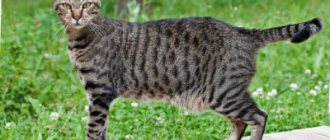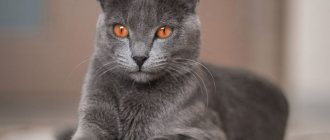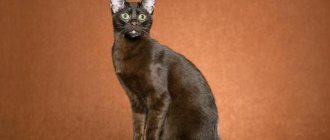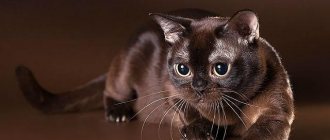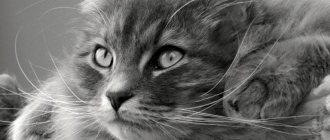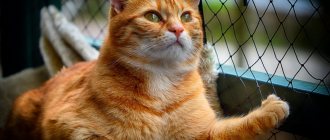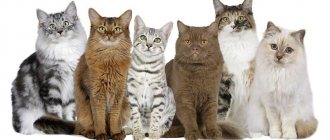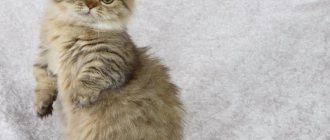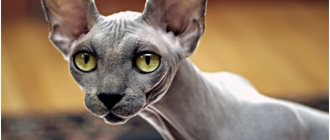Cats are mysterious and useful animals. Not every person tolerates contact with them well and can keep representatives of ordinary breeds in their home. Some suffer from an allergic reaction. An animal appears nearby, causing eye irritation, watery eyes, redness of the skin, itching, sneezing, runny nose, nasal congestion, coughing, shortness of breath, wheezing. Allergy sufferers can enjoy the company of animals as there are hypoallergenic cats. Hypoallergenic cat breeds are safe for allergy sufferers. We will tell you in detail about this miracle of nature below.
What cat breeds are hypoallergenic?
We present to our readers the top hypoallergenic representatives of the cat family. Let's list the most popular breeds with which breeders prone to allergies successfully live.
Canadian Sphynx
People with defective immune systems have good contact with the charming Canadian Sphynxes. For some reason, these hairless cats lead the statistics and have the highest hypoallergenic qualities. It is not possible to give a scientific explanation for the fact that out of a whole range of representatives of hairless animals, people most often give preference to Canadians. In terms of demand, they outperform other good breeds - the Don Sphynx, Bambino, and Ukrainian Levkoy. It is the Canadian breed that is the oldest, perhaps for this reason there is such keen interest in it.
Canadian Sphynx
Don Sphynx
The second most popular breed, the Don Sphynx, originated from a half-hairless cat, the breed was discovered and began to be bred not so long ago, about 3 decades ago, and is not ancient. These friendly animals help their owners relieve headaches, help improve the condition of nervous disorders, relieve muscle pain, and speed up the treatment of diseases of the musculoskeletal system. The breed is as close as possible to hypoallergenic status.
Don Sphynx
Peterbald
St. Petersburg Sphynxes are sophisticated, intelligent, graceful, kind and non-aggressive. The ancestors of the breed are Oriental cats and Don Sphynx cats. From these representatives, the Peterbalds inherited a wonderful energy, which the owners feel well, and an intelligent character. Many allergy sufferers get along with the breed without suffering from the animal. A cat without hair, but can purr attractively, does not oppose manifestations of love from a person. To protect against allergies, you only need to bathe such a cat on time. Otherwise, care is the same as for other hairless animals.
Peterbald
Cornish Rex
The Cornish Rex breed has an earl's character and English roots. Of the features, it is necessary to note a high-quality coat of body with curls, an easy-going disposition. The Cornish Rex breed is a playful and mildly allergenic friend. Hypoallergenicity increases if bathing is done in a timely manner. In this case, there is a minimum of allergy-provoking proteins in the wool. There are many of them on the body of furry breeds.
Cornish Rex
Devon Rex
The Devon Rex breed has an incredibly rich inner world, a minimum of fur, and an original winged ear shape. The less hair an animal has, the lower the likelihood of suffering from the Fel-D1 substance. In the habitat of these cats there is practically no hair, which means that protein harmful to allergy sufferers does not spread throughout the home. It is known that the Devon Rex has high intelligence, is undoubtedly hypoallergenic, and even tries to help its owners in everyday life.
Devon Rex
Cat Likoy
At first sight it is almost impossible to fall in love with the Lykoi breed. She has a very unusual appearance. It would seem that this is something like an ugly duckling. In fact, this is not so, this cat has many advantages. The magical appearance and all the advantages can only be seen upon close acquaintance. The breed was not bred artificially. It was assumed that experts were developing a new bald breed, but instead of smooth skin, the founders had bald spots on their bodies. This type of cat is not a type of Sphynx. In fact, this is one of the representatives of short-haired domestic cats. Werewolves from the cat family do not have a rich skin, and the existing coat is not supplemented with undercoat. This fact probably makes the breed hypoallergenic.
Likoy
Siberian cat
The Siberian breed has a native Russian soul. These mysterious animals are depicted in the form of cast iron sculptures; they are installed in a park in the city of Tyumen. As a general rule, a hypoallergenic cat should have sparse hair or completely hairless skin. This rule does not apply to Siberians. The wool does not get wet, animals do not freeze in the cold, do not provoke allergies, and behave calmly. It is impossible to give an adequate explanation for this effect. The breed is non-allergenic for 75% of all people at risk of allergies.
Siberian cat
Javanese
You should not think that the Javanese breed is of Armenian origin, judging by the sound of the name. Cats have hypoallergenic fur; they came to us from America. The Fel-D1 substance is released minimally. In fact, the breed was named in honor of the island of Java. Javanese cats have a shiny, rich coat of charming colors. There are color options for such cats - these are colors with medallions, one-color color, smoky, Siamese party-color and classic party-color, torby, shaded, tortoiseshell, tabby.
Javanese cat
Oriental cat
Another American breed is the Oriental. This is an example of a hypoallergenic cat. These animals once originated in Thailand. Although specialists from America worked hard on breeding Orientals and took care of the design of the breed. The cats are slender, short-haired, do not cause allergies, and hopelessly make people fall in love with them. From this breed you can get the desired result - an obedient and not evil character.
Oriental cat
Balinese cat
Hypoallergenic Balinese cats are animals with an athletic body and a moderate coat. This is one of the subspecies of Siamese cats, it is considered semi-longhaired. Watching Balinese cats, you can understand that they resemble dancers who move smoothly and gracefully.
Balinese cat
Russian Blue
© shutterstock
Russian Blue cats are stunningly beautiful and are often dark gray or blue in color. They shed heavily, transitioning between summer and winter for about two weeks, but the rest of the year they shed minimally and are unlikely to cause serious allergic reactions. Regular brushing during these periods of heavy shedding will help reduce even seasonal shedding.
How to choose a hypoallergenic cat?
Price of a hypoallergenic cat
Approximate price range for safe cats:
- A champion breed in terms of allergenicity costs from 5,000 to 25,000 rubles;
- Don Sphinxes are sold for 5,000-30,000 rubles;
- Peterbald breed - 5000-15000 rubles;
- Cornish Rex - 5,000-30,000 rubles;
- Devon Rex - 10,000-30,000 rubles;
- Likoi - from 5,000 rubles;
- Siberian cat - 500-10,000 rubles;
- Javanese cat - 20,000-100,000 rubles;
- Oriental cat - 5000-50000 rubles;
- Balinese cat - from 15,000 rubles.
List of cats for people with asthma and allergies
The best breeds for allergy sufferers and asthmatics:
- The Balinese cat is an animal with long hair, which contains a minimum of dangerous protein that provokes allergies;
- Javanese cat - has a particularly fine coat structure, no undercoat, and produces few allergens;
- Devon Rex are ultra-clean animals with short hair;
- The Cornish Rex is an independent, brave, intelligent, short-haired animal; if you bathe such a cat often, then the risk of allergies is minimal;
- Sphynxes are hairless, hypoallergenic animals, they are kind, inquisitive and sociable;
- Siberian cat - the medium-long fur of this animal releases very little allergenic material into the environment;
- The Asher cat is a new large animal with a leopard skin; the developers of the breed assure that cats do not provoke allergies at all, but there have been no studies yet;
- The Allerka cat is an artificially bred animal; according to the creators, the animal’s genes are modified so that there is no production of the Fel-D1 protein.
Hypoallergenic cats for asthmatics
About 40% of all asthma patients suffer from allergies to cats. They should avoid contact with animals or, as a last resort, get a hypoallergenic breed. If asthmatic cat lovers live in the room, then it is advisable to give preference to a Thai or Siberian cat. Most contacts are successful and are not associated with a negative reaction from patients. Ural and Cornish Rex are also acceptable for people prone to allergies, as they have curly coats. There is no undercoat in the skin, only guard hairs.
The most dangerous cats for people with allergies
Cat intolerance is twice as common in humans as dog allergy. It is important to know that allergies can be caused not only by long-haired cats, but also by short-haired and hairless cats. Ailments appear due to protein, which is found in urine, saliva and exfoliating dead particles of the skin. A weakened immune system is unable to protect the body, so it reacts with allergies. The body fights the pathogen and a number of side effects occur - allergic manifestations.
We also note that the greatest harm to allergy sufferers comes from cats that are allowed to go outside. The fact is that wool collects a huge amount of other potentially dangerous substances. Allergies can be caused by these frequent companions of walking cats - dust, pollen, fluff and mold. It turns out that the source of irritation for an allergy sufferer is not only the fur itself, but also everything that accumulates in it. From all this, the conclusion follows that for allergy sufferers, you should choose a cat not by the length of its coat, but by the intensity of production of the allergenic protein (so-called hypoallergenic cats produce less Fel-D1 protein, others more). It is also important that you definitely need an animal that lives only at home and does not go for walks.
Cat breeds without undercoat
It is the absence of undercoat that is a significant factor in choosing a cat for allergy sufferers and asthmatics. It is good when the coat consists of guard hairs. There is no shedding as such, which means that fur does not spread throughout the apartment and allergy attacks do not occur. Sphinxes and Rexes are champions in this regard. Tonkinese, Siamese, and Oriental breeds also shed little. Today the Javanese cat is especially popular.
The most hypoallergenic cat breeds
It has been noticed that the least likely complaints about allergies are among breeders of Canadian, Donskoy, and St. Petersburg Sphynx cats. They are great friends. Of course, there are many other hypoallergenic breeds, but these three are the undisputed leaders.
Oriental Shorthair
Oriental Shorthair cats have a quirky appearance with large ears that stick out comically far from the head. These cats have long, shallow noses, which give their faces a humanoid appearance. Their ears are their most prominent feature, with large pink satellites extending into the air like bat wings.
There are long-haired and short-haired varieties of Oriental cats, while short-haired is the light-haired variety. Their coat is very thin, shiny and velvety, adheres to the skin and does not shed noticeably. Although this breed is not technically hypoallergenic, it does produce less dander, which can cause allergies in humans.
Reviews from owners of hypoallergenic cats
Margarita, Moscow
I am sharing my experience that I gained while keeping several hypoallergenic cats. Every allergy sufferer should keep in mind the fact that the name hypoallergenic does not indicate that allergies from certain animals never occur. In reality, we are talking about a minimal likelihood of developing an allergic reaction due to the lower production of potentially dangerous protein by the animal’s body. I found out that there are no completely hypoallergenic breeds in nature.
David, Samara
In some literature there is an assumption that cats are much less likely to provoke allergies than seals. And another hypothesis - light-colored animals are less dangerous than long-haired ones. You can confirm or refute these facts, but you need to check everything for yourself. The above breeds are called hypoallergenic not because they do not cause allergies, but because they produce the Fel D1 protein in minimal quantities. I have allergies and live happily in an apartment with Sphinxes.
Svetlana, Volgograd
When you make your choice, most likely it will be the breed from this review, start studying safety precautions. I give you some valuable advice. You should bathe your pet 2 or 3 times a week. It is better that the cleaning is done by a person who does not have problems with allergies. Wet room hygiene is required weekly. After petting your cat, be sure to wash your hands. Every day it is necessary to wash the cat’s bowls and personal belongings - toys and more. When you take on a certain breed that you are not yet familiar with, you need to get as much information as possible about it.
According to statistics, about 15% of the world's inhabitants are predisposed to an allergy to ordinary cats, and in one way or another they encounter it. Hypoallergenic animals, although they do not completely protect against allergies, still significantly reduce the likelihood of a negative human reaction to fur and epithelium.
Devon Rex
The Devon Rex is a curious cat breed, beloved for its bold nature and low-shedding coat. The Devon Rex's coat is very short, slightly curled and close to the body. These cats practically do not shed, although they may lose their fur several times a year as the seasons change.
Although the Devon Rex is not a hypoallergenic pet, its minimal shedding makes it a better option for those with allergies.
This breed is very playful and they quickly become attached to their owners. Devon Rex dogs follow their owners everywhere, playing games, begging for food, or using their claws to get attention. Although they don't shed much, the need for cuddles can make those with allergies become more attached to Devon Rex cats.
Veterinary question
If it is not clear why the cat sheds a lot, the fur falls out in clumps, or bald patches appear, then its health and immunity need protection.
Wool is actively involved in the body's defense processes, so make every effort to restore your pet's immune balance. A veterinarian and a blood test for hormones will help with this.
Two groups of diseases can be considered, which are diagnosed by the volume and quality of baldness. These are parasitic diseases and endocrine pathologies.
Parasites can be easily detected by scratching and brittle hair on the neck, behind the ears, at the base of the tail and on the tummy. Endocrine disorders are usually expressed by symmetrical baldness (there is no hair at all on rounded bald patches).
Sometimes the cause of the loss of the spine and down is a recent illness. If little time has passed since the cure, then excessive shedding in the coming season is considered a physiological norm.
We put these three reasons on a par because there are many interrelations between them. Allergies often manifest themselves under stress, and poor nutrition can provoke allergic reactions at any time of the year.
First of all, switch your cat to a balanced diet for sensitive and allergy-prone pets.
Find out what the cat's metabolism is lacking, eliminate stress and check whether preventive measures have been taken for a long time.
If your purr constantly sheds, but no diseases are found in him, then you need to consult with a specialist on what to do and how to properly care for his coat in order to keep it healthy and beautiful.
The result of any of your efforts and treatment can be assessed in the coming season. When the cat begins to shed regularly only in spring and autumn, we can assume that you have found the ideal balance between nutrition, care and breed characteristics of your pet.
Or maybe vitamins?
As we have already said, almost all cats shed – some to a greater extent, some to a lesser extent. What vitamins should I give if my cat sheds a lot? In fact, no remedies are needed for them, unless there are allergic reactions, some hormonal changes, etc. Only a doctor can determine them.
If, nevertheless, no diseases are detected, you can give cats vitamins that will prevent hair loss. These can be either specially developed complexes or any vitamins that contain iodine, sulfur, seaweed extract and B vitamins. Complex vitamins are good because they have a balanced composition, including minerals.
Popular vitamin complexes that can take good care of your pet's fur include Kitty's + Taurin + Biotin, Cat–Fell OK, Laveta Super for Cats, Derm Caps and Derm Liquid. They contain biotin, zinc, taurine, and entire groups of vitamins, which together maintain the natural beauty of animal hair and prevent skin diseases.
Among the popular vitamin complexes are Kitty's + Taurin + Biotin
Remember that any vitamins can be given only after your pet has been examined by a veterinarian, as otherwise it can cause harm.
conclusions
These are just a few of the most common breeds of non-shedding, non-smelling cats.
In fact, the choice for beginning cat owners is not limited to just four types of cats, and also includes breeds such as the Munchkin, Peterbald and many others.
Munchkin cat.
Peterbald cat.
Thanks to this variety, every cat lover will be able to choose an animal according to his preferences, without fear that it will begin to shed or that the apartment will become saturated with unpleasant odors.
Sphinxes
Sphynxes are one of the few breeds that have virtually no hair. Their hairlessness is a mutation. The degree of baldness depends on age; by 1-2 years of life the animal acquires its final appearance.
Types of sphinxes:
- Hungerborn. Kittens do not have fur. They may lack whiskers and whiskers.
- Flock. Instead of the usual fur, the body is covered with thin and short fluff. It feels like velor to the touch.
- Brush. The body of the animals is covered with dense and sinuous hair. By 3-5 years they are completely bald.
Sphynxes are great for allergy sufferers, because Sphynxes will definitely leave no hair in the house.
Or maybe vitamins?
As we have already said, almost all cats shed – some to a greater extent, some to a lesser extent. What vitamins should I give if my cat sheds a lot? In fact, no remedies are needed for them, unless there are allergic reactions, some hormonal changes, etc. Only a doctor can determine them.
If, nevertheless, no diseases are detected, you can give cats vitamins that will prevent hair loss. These can be either specially developed complexes or any vitamins that contain iodine, sulfur, seaweed extract and B vitamins. Complex vitamins are good because they have a balanced composition, including minerals.
Popular vitamin complexes that can take good care of your pet's fur include Kitty's + Taurin + Biotin, Cat–Fell OK, Laveta Super for Cats, Derm Caps and Derm Liquid. They contain biotin, zinc, taurine, and entire groups of vitamins, which together maintain the natural beauty of animal hair and prevent skin diseases.
Among the popular vitamin complexes are Kitty's + Taurin + Biotin
Remember that any vitamins can be given only after your pet has been examined by a veterinarian, as otherwise it can cause harm.
According to your lifestyle
The situation in the house and the owner’s life principles are an important aspect when choosing a cat breed. Not all breeds will be comfortable in every family.
For busy people
If the owner is rarely at home, he needs a cat that does not require a lot of communication and care. Such a pet must have a self-sufficient character.
Check out the following cat breeds if you consider yourself a workaholic:
Woman looking out the window
Scottish cat
They do not require unnecessary attention. Such cats will happily greet their owner from work, but will not bother him if he is not in the mood. These pets do not require complex care and will always find something to do on their own.
For children
If a child asks to buy a kitten, choose from good breeds of cats. The pet must be patient so as not to get angry from pranks. Breeds that will enjoy children's play:
Good disposition and doggy character
Devoted entertainer
Obedient purring beauty
Turkish van
Suitable for a child if he becomes his owner. For children, you should not choose wayward cats and pets who prefer a quiet holiday. Incompatibility of interests leads to cat and child trauma.
For single people
People living alone often lack communication. Such a person should choose a cat with an affectionate character. Devoted cats will happily brighten up the evenings with their purring:
Curious and funny talker
Japanese Bobtail
Loyal purring friend These cat breeds become attached to people and love attention. Such cats will create comfort in your home and will bring you extremely positive emotions.
For a private home
A person living in his own home needs a hunter cat. The pet must be able to exterminate rodents and walk in the yard on its own. If your home needs a rat catcher, take a look at the following breeds:
Turkish van
Pied Piper from the Eastern Continent Natural rat catchers will always stand guard over their master's house. To catch rats, it is better to choose a cat rather than a cat: they show the best hunting qualities.
For a family that already has pets
One pet in the house is never enough - there is enough love for everyone! To ensure smooth communication between your old and new pet, choose from friendly cat breeds:
